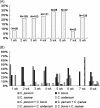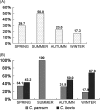Characteristics of Cryptosporidium transmission in preweaned dairy cattle in Henan, China
- PMID: 21177898
- PMCID: PMC3067708
- DOI: 10.1128/JCM.02194-10
Characteristics of Cryptosporidium transmission in preweaned dairy cattle in Henan, China
Abstract
To estimate the prevalence and public health significance of cryptosporidiosis in preweaned calves in China, 801 fecal samples from eight farms in seven areas in Henan Province were examined for Cryptosporidium oocysts. The overall infection rate of Cryptosporidium was 21.5%, with the farm in Xinxiang having the highest prevalence (40%). No significant difference in infection rates was observed between seasons. Cryptosporidium spp. were characterized by PCR-restriction fragment length polymorphism (RFLP) analysis of the small subunit (SSU) rRNA gene and DNA sequencing of the 60-kDa glycoprotein (gp60) gene. The SSU rRNA-based PCR identified four Cryptosporidium species, including Cryptosporidium parvum (54/172), C. bovis (65/172), C. ryanae (19/172), and C. andersoni (12/172), and the occurrence of infections with mixed species (22/172). The earliest detection of C. bovis was in calves of 1 week of age, showing that the prepatent period was shorter than the previously stated 10 to 12 days. Infections with C. parvum peaked in summer, whereas C. bovis dominated in autumn and winter. There was no apparent difference in the age of cattle infected with either C. parvum or C. bovis. Sequencing analysis of the gp60 gene showed all 67 C. parvum samples belonged to subtype IIdA19G1. These findings suggested that the transmission of Cryptosporidium spp. in preweaned calves in Henan, China, appeared to be different from other areas both at genotype and subtype levels. Further molecular epidemiologic studies (including samples from both calves and humans) are needed to elucidate the transmission dynamics and public significance of C. parvum in cattle in China.
Figures


References
-
- Abe N., Matsubayashi M., Kimata I., Iseki M. 2006. Subgenotype analysis of Cryptosporidium parvum isolates from humans and animals in Japan using the 60-kDa glycoprotein gene sequences. Parasitol. Res. 99:303–305 - PubMed
-
- Amer S., et al. 2010. Cryptosporidium genotypes and subtypes in dairy calves in Egypt. Vet. Parasitol. 169:382–386 - PubMed
-
- Broglia A., Reckinger S., Cacció S. M., Nöckler K. 2008. Distribution of Cryptosporidium parvum subtypes in calves in Germany. Vet. Parasitol. 154:8–13 - PubMed
-
- Brook E. J., Anthony Hart C., French N. P., Christley R. M. 2009. Molecular epidemiology of Cryptosporidium subtypes in cattle in England. Vet. J. 179:378–382 - PubMed
Publication types
MeSH terms
Substances
Associated data
- Actions
- Actions
- Actions
- Actions
- Actions
LinkOut - more resources
Full Text Sources
Medical
Molecular Biology Databases
Miscellaneous

